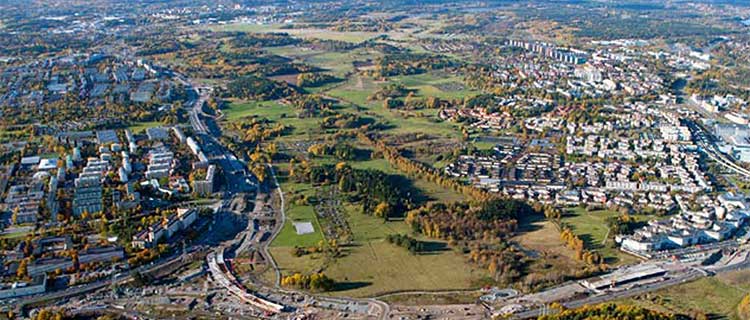
Urban planning
Dealing with deadlocks and dichotomies
How resilience thinking can be useful in urban planning
- Study presents three ways that resilience theory can be useful in urban planning and management of green areas
- From an urban/landscape dichotomy perspective the study uses a case of urbanizing area, Järva, Sweden
- Study emphasizes the importance of creating common ground when discussing changing green areas
To protect or not protect, that seems to be the question when it comes to urban planning. When large-scale green areas are protected, they are viewed ideally as an antithesis to the city, part of a dichotomy where land is isolated and protected from human disturbances, all seemingly free from social and ecological interactions.
Surely we can do better.
At the very core of resilience research is the conviction that humans and nature are so strongly connected to the point that they should be conceived as one social-ecological system.
In a study recently published in Planning Theory and Practice, centre researchers Sara Borgström and Erik Andersson together with Hanna Erixon from The Royal Institute of Technology have looked at ways to introduce this coupled thinking into urban planning projects. Using resilience science as their point of departure, the researchers present three ways resilience theory can be useful in the planning and management of large urban green structures.
Making it work
Firstly, resilience can help to highlight a wider array of actors that together can strengthen collaboration (provided they pull in the same direction). Secondly, resilience, as built on the idea of adaptive capacity and learning in times of change, can provide creative ways out of project deadlocks. Thirdly, resilience can serve as the theoretical reference point for a more consistent understanding of how large-scale urban green structures should be developed.
How can this be implemented in real-life urban planning?
In a series of workshops between 2007 and 2010, Erixon, Borgström and Andersson invited 16 participants from a diverse field of urban expertise including architects, designers, ecologists and city planners to explore "more operative and integrative approaches to large-scale urban green structures.”
Using resilience theory as a lens they applied it to a case study of Järva, a booming suburban area in the north-western part of Stockholm. The area is locked in a situation of seemingly incompatible endeavours of protecting green areas on the one hand and creating a dense and more connected urban area on the other.
"The dualism seen in Järva is typical for Stockholm and is reflected in both planning discourse and planning practice"
Erik Andersson, co-author
In the past decade, extensive parts of the large-scale green structure of Stockholm have become formally protected through reserves, but it has also contributed to increase what Andersson and his colleagues call "the urban/landscape dichotomy”.
Elastic and pliable
The discussions from the workshops revealed a strong desire to "find a new logic" but also highlighted the difficulties in breaking free from the urban/landscape dichotomy. More "elastic and pliable" approaches based on social-ecological resilience could potentially unlock this regime but many participants also pointed towards the difficulties brought about by an increased complexity and level of detail when dealing with increasingly connected social-ecological systems.
"Particularly within city-wide planning professionals are often asked to present more simplified measurements, figures and specifications like "how wide must a green corridor be in order to function?" What specific species are we trying to save here?," says Erik Andersson.
"When attempting to bring in more open-ended data and socio-ecological overlays of information, there seemed to be tangible limits to how much information they felt was helpful."
Get people together
Andersson and his colleagues acknowledge that within urban planning there will always be tensions between protection and accessibility, or "green spaces" and "built-up areas".
However, there might be more constructive ways of handling such tensions.
One direct implication for planning lies in the recasting of planning methods so that more detailed and scenario-based ecological information is accommodated in earlier and more strategic phases of the process. Another important aspect is change and how this can be integrated into landscape planning.
"Resilience thinking acknowledges change as an inherent part of natural systems. This paves the way for more active and creative approaches to how we work with urban green areas. Indeed, viewing landscapes as impermanent and dynamic can be both liberating and challenging for designers, planners and managers,” says Hanna Erixon.
Finally, Erixon and her colleagues emphasise the importance of creating a common ground for all parties involved in the maintenance of urban green areas.
"Management based on resilience theory recognizes the importance of diverse stakeholders. This means that planners, urban designers, ecologists, landowners and users of the green spaces all need to share a consistent, or at least not a totally contradictory understanding of how the areas should be managed.”
Through scenarios and tentative design, they conclude, these principles of resilience can help boost projects that are not moving forward at all.
CITATION
H. Erixon , S. Borgström & E. Andersson (2013) Challenging dichotomies – exploring resilience as an integrative and operative conceptual framework for large-scale urban green structures, Planning Theory & Practice, 14:3, 349-372, DOI: 10.1080/14649357.2013.813960
Erik Andersson holds a PhD in natural resource management and systems ecology. His main research interest is in functional landscapes and the spatial framework that influences human interactions with nature.
Sara Borgström's research addresses the interface of urban development and nature conservation from a landscape governance perspective.






